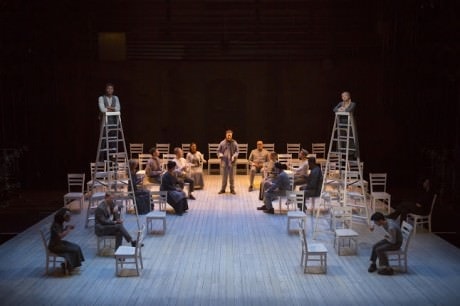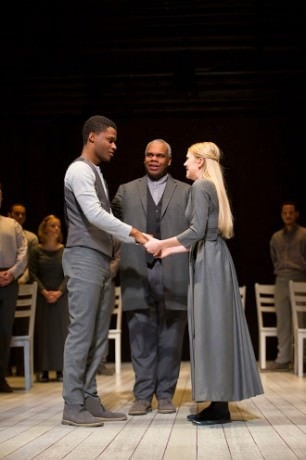You have to love life to have life and you have to live to love it. But so few of those who have life even realize that they have it let alone love it. That dawning realization flashes through words three quarters of a century old as Ford’s Theatre presents Thornton Wilder’s Our Town. Directed by Stephen Rayne, this iconic American play is presented with a sharp modern edge, maintaining the integrity of the story while keeping it exciting and new for audiences everywhere. A deeply introspective look at small town life at the turn of the 20th century straight from the mountains of New England in a little place called Grover’s Corners, this production is thought-provoking and profound with its approach to breaking the fourth wall.

Costume Designer Kate Turner-Walker highlights the importance of vivacity through her use of a monochromatic grey color scheme; life’s excitement coming not from the colors on you but the colors that are inside of you. The significance of how people in life don’t see how bright and shiny their lives are is paralleled in this design choice by saving gleaming white outfits for moments in the third act. The monotony of the everyday life is reflected in Turner-Walker’s work and creates a unique approach to the minimalist idea behind the overall production design. We as human beings do not realize the liveliness of our own lives while living them, a crucial concept of Wilder’s work, is well encompassed in the costumes of this show.
Lighting Designer Pat Collins creates small wonders on the stage with the subdued and subtle shifts in focus throughout the production. Collins draws precise focus to the foreground and background respectively when the narrator is focusing on present action or when the ensemble is meant to be the center of attention. Tight spotlights with soft blueish white glows are used to create glorious moonlight for scenes out the bedroom windows or down in the gardens at night. Collins’s work is picturesque, the perfect enhancement to this imaginative production.
The notion of scenery falls heavily on the mind of the audience as the initial stage directions call for “no curtain, no scenery.” Scenic Designer Tony Cisek keeps true to this minimalist approach with a few slight changes. The stage itself has a sharp sloping rake that leads upward to the back of the performance space and other than two dozen or so white chairs the houses of Doc Gibbs and Mr. Webb are left solely to the audience’s imagination. Cisek uses this ingenious layout of chairs to keep the ensemble ever present on stage as well as creating the illusion of rows of houses or buildings that are the town. Tall A-frame ladders are used to give the kids the appearance of being up in their bedrooms during the moonlit scenes, and the chairs are put to their full use in act III— in a way that must be seen to be believed.
As there is no scenery it can only be expected that there will be no props. This lack of physical things, however, does not in the least hinder the actors ability to convincingly go about their daily chores of making breakfast, delivering paper and milk, and plucking beans for the winter in the back garden. Movement and Mime Director Mark Jaster shares his vast knowledge of the human body as an expressive vessel with the cast creating realist and lifelike gestures that ultimately allow the audience to believe what they are seeing while still living true to Wilder’s notion that this is not real life but a play on real life. Jaster works with the actors to create convincing moments of the ladies of the household cleaning up and preparing meals in the kitchen, as well as working with the beans in the garden. The gestures are fluid, not over exaggerated, but still expressive and often come with sound effects performed by the actors to enhance the movement, like Mrs. Webb and Emily in the garden making the snapping sound of the beans as they pluck them.
Director Stephen Rayne working with Sound Designers David Budries and Nathan A. Roberts create a world of simplistic sound on the stage by utilizing the performers to their full potential. The audience can almost see Bessie the horse on stage when they hear the soft clip-clop of her hooves and hear her airy braying and whinnying; all sound effects made by the hands and mouths of those on stage. The pitter patter of rain is light tapping on thigh-tops and the slight rumble of thunder comes from rapid bouncing feet against the floorboards. Budries and Roberts create this splendid atmosphere of ‘almost real’ by utilizing the performers in this manner.
Rayne’s choice to carefully select moments of the production to show the audience while allowing the Stage Manager (Portia) to explain the rest is an incredible way of condensing this production into a manageable and enjoyable show. It allows the stage manager to interact more readily with the audience, part of Wilder’s “fourth-wall breaking” design while keeping them engaged and interested in all that happens on the stage. We see key moments like the Webb-Gibbs wedding and moments of precise interaction between characters that helps to move the story along without getting bogged down in the exposition and explanatory details of the play.
The performers themselves are nothing short of brilliant. Rich and engaging and often deeply realistic they create a world all their own upon the stage which they are eager to share with the audience. Guided by Portia, playing the role of the ‘stage manager’ who is more of the story’s narrator than anything else, the actors bring to life a tale as plain as our everyday lives, while still managing to keep it interesting for those watching.
Portia is a spunky personality with a zest to her that really keeps the audience with her through all that she says. Her initial narrations are slow and precise, outlining each detail of Grover’s Corners with such perfect enunciation and articulation that you can almost see the town being created as she speaks. But once she falls in step with the flow of the performance a more gripping persona surfaces, encouraging the characters to move things along. She has a sharp edge about her, which keeps the play lively while maintaining the integrity of its seriousness. Portia drives the focus of the production while keeping both the audience and the performers on track; ever present on the stage even when she’s not speaking, creating the illusion that she is the master of the story, the keeper of the tale. A sensational performance with a revitalized life to Wilder’s work, Portia is thoroughly enjoyable in this role.
The other key actors have carved their personalities the same way their characters have been carved into the niche of Grover’s Corners. Howie Newsome (Kevin McAllister) is laid back, set in his ways but warm and friendly, while Joe Crowell Jr. (Christopher Wilson) is a bit more jumpy and spirited but with that same neighborly approach to him. Simon Stimson (Tom Story) the town drunk lets his actions speak for themselves while Mrs. Soames (at this performance Erin Driscoll) is a sharp squeaky town gossip with her nose in everyone’s business and her opinions overtly exposed. Together each of these unique and well-defined characters makes up the completeness of the town; giving it depth and reality.
Doc Gibbs (James Konicek) is a polite little cloud of gloom that hangs persistently over his wife, Mrs. Gibbs (Jenn Walker). Walker manages to break through the humdrum dreariness like a bright ray of sunshine, nervous yet hopeful in her mannerisms and tone of voice. Konicek may have a more somber approach to things, but he radiates the subtleties of love when it comes to both his wife and children.
Mr. Webb (Craig Wallace) and Mrs. Webb (Kimberly Schraf) are a congenial working married couple. Wallace is fatherly in the keenest sense of the word, doting on his daughter with warm smiles and polite affection while giving solid advice when needed. Schraf is a simplistic motherly figure, balancing her gentle nurturing with wisdom and poignant thoughts. Together the pair make a good foil to the Gibbs couple, and ultimately their scene together in the third act is beyond precious with a deep hidden meaning riding beneath it.
It all comes down to the children, however. The next generation, the continuation, the hope for the future. George Gibbs (Nickolas Vaughn) and Emily Webb (Alyssa Gagarin). Together the pair have a sweet flirtatious romance that slowly bubbles with the innocence of young love. Vaughn is polite and charming without being too sweet, focused on baseball and with just enough charisma to be focused on Emily as well. His portrayal of this spirited youth is brilliant; feeling natural and fun to watch. He carries a touch of the melodrama with him but it only stands to enhance his character in the scenes where he shows it.
Gagarin as the story’s central focus for act II and beyond is a well-rounded performer working her way through a plethora of emotions and feelings that are often accompanied with adolescence and young love. Initially a confident girl there is a working incongruity between her pride in her intellect and her ignorance about the world outside her schoolbooks, largely pertaining to life and love in the most general sense. Gagarin portrays a sweet innocent youth who at times has a whiny disposition and can be slightly stubborn. But her stunning moments happen late in the final act; a harrowing and moving monologue that brings the audience to tears as her character delves past the point of no return in a deeply remorseful speech filled with realization that has come too late.

Ford”s Theatre’s Our Town is a phenomenal presentation of a great American classic, filled with brilliant actors creating one sensational production. Don’t miss it!
Running Time: 2 hours and 30 minutes, with two 10-minute intermissions.
Our Town plays through February 24, 2013 at Ford’s Theatre – 516 10th Street NW in Washington, DC. For tickets, call the box office at (202) 347-4833, or purchase them online.





Hi Amanda,
I’m new to DCMTA writing. Just wanted to tell you that I enjoyed your excellent review.